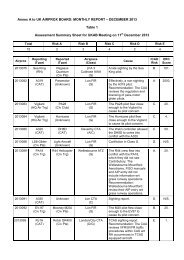STATISTICS 2016
DUKES_2016_FINAL
DUKES_2016_FINAL
Create successful ePaper yourself
Turn your PDF publications into a flip-book with our unique Google optimized e-Paper software.
1.23 Total expenditure by final consumers in 2015 is estimated at £113,810 million, (£113,475<br />
million shown as actual final consumption and £335 million of coal consumed by the iron and steel<br />
sector in producing coke for their own consumption). This is down by 9.5 per cent on 2014, with the<br />
most significant changes being the reduced price for crude and petroleum products. In 2015, crude oil<br />
prices averaged $52 per barrel, down sharply compared to the average of just under $100 per barrel<br />
in 2014, which was itself down from the average $110 per barrel in the three previous years. Chart<br />
1.6 shows energy consumption and expenditure by final users.<br />
1.24 The value balance demonstrates how the value chain works in the production and consumption<br />
of energy. For example, in 2015, £12,260 million of crude oil was indigenously produced, of which<br />
£9,920 million was exported; and £13,365 million of crude oil was imported. Allowing for stock<br />
changes, this provides a total value of UK inland crude oil supply of £15,715 million. This fuel was<br />
then completely consumed within the petroleum industry in the process of producing £22,790 million<br />
of petroleum products. Again, some external trade and stock changes took place before arriving at a<br />
basic value of petroleum products of £25,450 million. In supplying the fuel to final consumers,<br />
distribution costs were incurred and some profit was made amounting to £2,005 million, whilst duty<br />
and tax meant a further £32,540 million was added to the basic price to arrive at the final market value<br />
of £60,265 million. This was the value of petroleum products purchased, of which industry purchased<br />
£1,650 million, domestic consumers for heating purposes purchased £975 million, with the vast<br />
majority £52,990 million, purchased by the transport sector.<br />
Chart 1.6: Energy consumption and estimated expenditure on energy by<br />
final users<br />
170<br />
Quantity (left hand scale)<br />
Value (right hand scale)<br />
150<br />
160<br />
125<br />
Million tonnes of oil equivalent<br />
150<br />
140<br />
130<br />
120<br />
100<br />
75<br />
50<br />
25<br />
£ billion<br />
110<br />
0<br />
0<br />
2000 2001 2002 2003 2004 2005 2006 2007 2008 2009 2010 2011 2012 2013 2014 2015<br />
1.25 Of the total final expenditure on energy in 2015 (£114 billion), the biggest share, 49 per cent, fell<br />
to the transport sector. Industry purchased 10 per cent (£11 billion), the domestic sector purchased<br />
29 per cent (£33 billion), with the remaining 12 per cent (£14 billion) purchased by the service sector.<br />
Sales of electricity and gas by sector (Table 1.7)<br />
1.26 Table 1.7 shows broad estimates for the total value of electricity and gas to final consumption.<br />
Net selling values provide some indication of typical prices paid in broad sectors and can be of use to<br />
supplement more detailed and accurate information contained in the rest of this chapter. More<br />
detailed information on energy prices is available in Energy Prices, available on BEIS’s energy<br />
statistics website at: www.gov.uk/government/collections/quarterly-energy-prices<br />
Energy consumption by main industrial groups (Table 1.8)<br />
1.27 This table presents final energy consumption for the main industrial sub-sectors over the last<br />
five years. So far as is practicable, the user categories have been regrouped on the basis of the 2007<br />
Standard Industrial Classification (see paragraphs 1.56 to 1.60). However, some data suppliers have<br />
18







